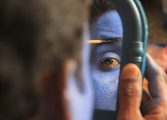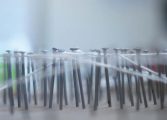Suresh’s current art practice can be best described as Event Art. The Event Art is located at the disjunction of rehearsed and serendipitous and they transpire in open public spaces. Although events are announced and audience invited, most often the viewers, are passers-by on the street. In its pure provisionality, the Event Art is akin to the idea of Event Architecture theorised by Bernard Tsuchmi. Tschumi conceives space, event and program as mutually exclusive and independent entities that are brought to confront, intersect, and alter each other creating new experiences of space. The events that are central in Tschumi’s thought are short durational situations that emerge out of dynamic movement of bodies, the interaction and interrelation between bodies in motion and objects. The Events carve out unexpected functions. A Program on the other hand is a combination of events composed of various independent, analogous or mutually exclusive sets. The architectural space then is an envelope that expands and contracts giving rise to unexpected functions as the events and programs are continuously changing (Tschumi, 1994, XXV). Unlike a theatrical performance that is scripted and rehearsed the Event Art as practiced by Suresh is episodic and junctural, although prefigured, it is unprepared and spontaneous. Like a chronotop they connect time and space. Spatially they are embedded in the city or a locality and temporally they connect past / present and employ biographical experience as sources for commentary on contemporary life.
In the last ten years, Suresh’s performances bring together the allegorical mode of early installation and the performative structure to make them into allegorical events. However these events have become more sophisticated, more deeply embedded in the biographical or historical experiences with material props that have complex meanings inaccessible without the contextual explanations. I am all Feather and Need a Breeze to Make Myself Feel so (2011) is one of the works reflective of this complex allegory wherein each prop is an element of past or present reality reconfigured in the event. I am all Feather needs to be read / viewed / understood on three interconnected levels. First on the level of the medium it employs: live video projection with performance. Second, on the objectal level the props employed in the event are taken from reality with deep significance. For example, the silkworms and the silk yarn wrapped around the artist’s waist connect them back to experiences of sericulture in his village and the installation Harvest for a Better Monsoon. The dried coconut branch on which the silkworms began to make a cocoon during the performance is taken from the last coconut tree that survived and eventually died when farmland was converted into JC Road in Bangalore. The key(s) are the objects around which memories of childhood are woven and at the same time they connect past and the present conditions of existence, both physical and mental. Suresh recalls his grandfather and father having just one key, whereas nowadays people have keys for everything: house, rooms, closets, cabinets, cars, offices and many more. Key is an ubiquitous metaphor for access, opening, a stepping stone and yet it is a metonymical fragment that is inalienably conjoined to lock and its associated significations. A key is indeed an access, but only to that which is enclosed, hidden and private. The farmland around Bangalore is now converted to private, enclosed and controlled spaces: gated communities for living, secured office complexes for working and closed malls for shopping. What Suresh’s performance reveals is the current urban phenomenon embraced as the ideal model of developed living. In the performance, as the silk worms start building a cocoon around them (projected on the wall), the artist resembling a silkworm with bodysuit, silk yarn, shaved head and dark circles around eyes, obsessively and incessantly ties keys around his waist as the loin-clothed key maker fashions them on a peddle powered lathe. I am all Feather is an allegory of new urbanism in India; the cocooning of the social into secured and privatized spaces with 24-hour security, optical surveillance and biometric access controls. And yet, the habitants put everything under lock and key; their outward joy of living in a paradise, undercut by constant threat of loss and the fear of the other.
Suresh Kumar, I am all Feather and Need a Breeze to Make Myself Feel so, 2011.
The closed spaces with limited views, the street and dynamics of private and the public reappear in another event created by Suresh entitled Tinted Glasses and Muted Streets (2012). In this, the audience are enclosed in a limited space with a glass window to look through while the performance takes place on an open street. It begins with a rag-picker (the artist) appearing on the street and peeling off the tinted film from the glass, allowing a clearer view of the street for those located inside and at the same time making them clearly visible to the street. The Tinted Glasses idea emerged in the context of a government order, banning tinted windows on cars. What was once a private space in the car behind the dark windows that would allow the traveller to gaze at the street without inhibitions is stripped of privacy and laid bare. In the open, without the tint, now everyone is under the Gaze and the uncanny feeling of being looked at results in guarded actions and averted looks. It is through this omniscient Gaze of the Other that the subject of lack is constituted and reconstituted continuously in the scopic regimes of modernity.
Suresh Kumar, Tinted Glasses and Muted Streets, 2012.
But like all machines, modernity too produces waste: the discarded and the unwanted that escapes visibility. Cobbler, Cobbler Mend My Feet (2012) calls attention to this waste that lays at such extremes, both materially as well as symbolically, that it can neither be incorporated back into the system nor does it disintegrate and disappear. Moreover, this waste appears unexpectedly and unwantedly like a glitch in the reality itself. This performance has as its main component, a showroom-like display of discarded shoes and sandals that Suresh collected from the streets of Bangalore. These are those shoes and sandals that broke on the way to somewhere and the owners realising that they are beyond repair left them on the street and walked the rest of the journey barefoot. The intensity of the use has reshaped the footwear in the image of the feet that wore them. Deep and fossil like impressions are the markers of dialectic between the feet and the footwear. Shoes have been mended, used and reused to such extremes that they are beyond repair. What can be mended now are only the feet.
Suresh Kumar, Cobbler, Cobbler Mend My Feet, 2012.
Un-mended feet or the feet that need mending again become the subject of another of Suresh’s performance, Outsider’s Barefoot Walk (2013) performed at Tel-Aviv Central Bus Station drawing attention again to the discarded. Suresh’s performance consisted of walking bare feet up the ramp of a 7-storied bus station inside a large Hula Hoop. This bus station once conceived to be the largest bus stand in the world and now mostly abandoned and detested by Israelis is, as Naomi Zeveloff writes, “a metaphor for Israel itself. The station’s various communities — the artists, the African asylum seekers, the Filipino workers, the hip hop musicians, the Mizrachi shop owners, the soldiers traveling to and from their bases, and even the observant Jews who worship in the station’s two synagogues — all seem to coexist but never truly overlap. And then there are the individuals who, for whatever reason, have chosen to spend their waking hours roaming the building’s concrete halls.” (Zeveloff, 2016) The Tel-Aviv central Bus Station is no different than ghost cities of China, empty malls of Gurgaon, India and ruins of company towns in Bangalore.
Suresh Kumar, Outsider’s Barefoot Walk, 2013.
The abandonment and waste resurfaces again as a theme of Suresh’s more recent work, SAIL (2015). On the one side of the wall is a video projection of a performance done by another artist Raghu Wodeyar in 2013 at Vrishabhavati, a river that flows through Bangalore city. Once a source of drinking water for the inhabitants of the city, the river is today a stream of flowing sewage and large swaths of the riverbed is covered with garbage. In the video, the artist Wodeyar dressed in a white hooded robe sits on the pile of the waste next to the stream and with a single ore repeats the motions of rowing. In Suresh’s work, the monochromatic video projection is complemented on the other wall with a printed image in colour of the video cut into pieces and reassembled as a relief. When SAIL was exhibited in Hamburg, Germany, Europe was experiencing an influx of refugees fleeing the Syrian war. Probably one of the finest works executed in recent times by Suresh, it brings together two desperate elements—garbage and the wars—that suffocate and destroy life. Garbage is the collateral damage of consumption and while the refugees are the waste generated by war (in fact some European politicians called the refugees of the war “human trash”). When the exhibition was on, Suresh and his daughter would make little paper boats and leave them on the floor for visitors to take home.
Suresh Kumar, SAIL, 2015.





